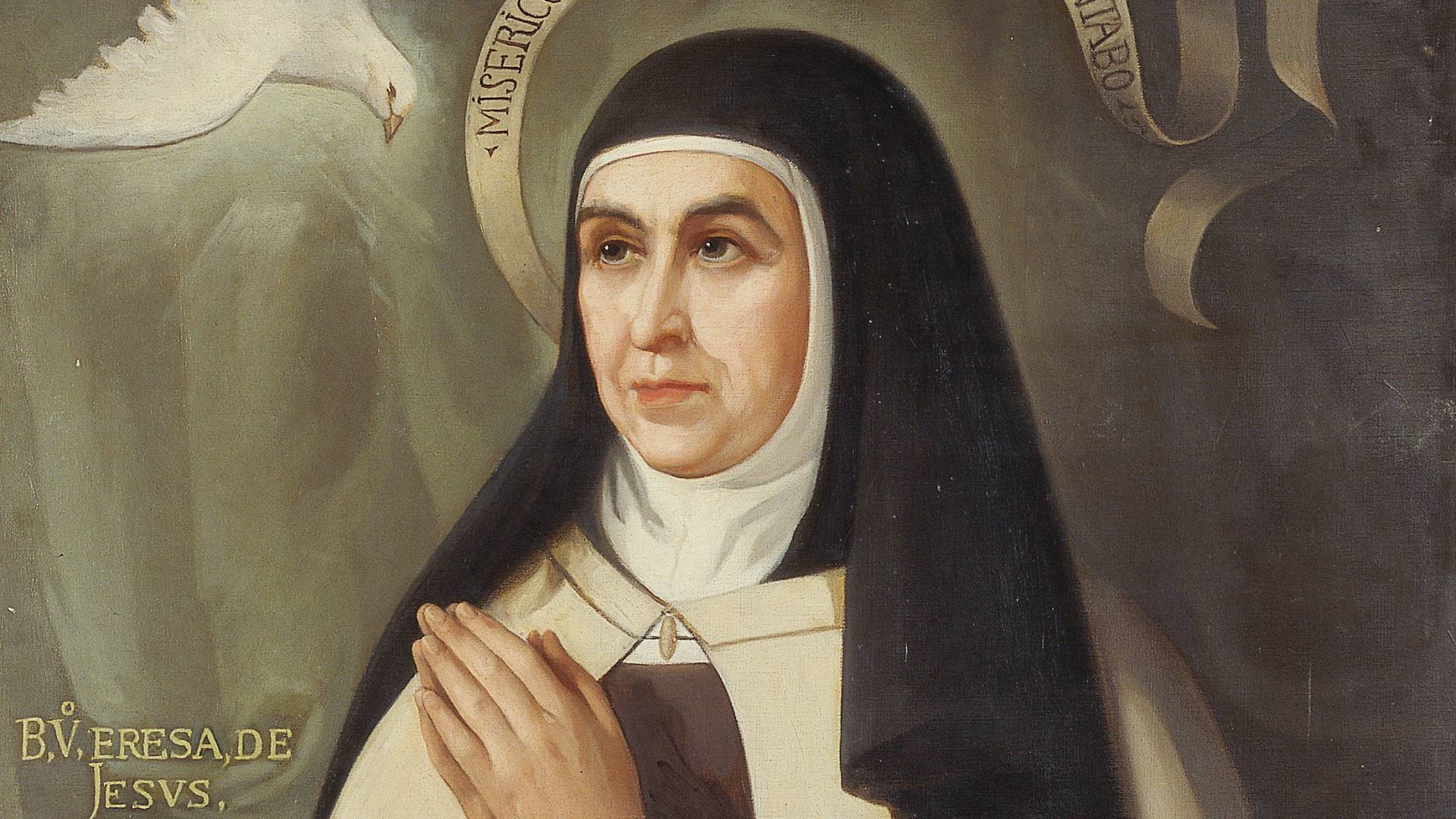

Deacon-structing St. Teresa’s stages of prayer, part 1
Deacon Pedro
Monday, February 22, 2021

Detail of Santa Teresa de Jesús by Eduardo Balaca (Source: Wikimedia Commons)
Last week, I suggested that a good thing to do to help us enter deeper into the mystery of the Church and to get closer to Christ is to participate in spiritual reading. I say “participate” rather than just “read” because the act of spiritual reading is more a prayer experience than merely reading a good text. When we engage in spiritual reading, we are engaging with the life of the Church, the lives of the saints, and the Body of Christ. It is a great way to complement our prayer life and also to grow closer to the Church.
Further, since there is so much confusion about what the Church teaches about this or that, the only way to really know what’s true is to get it from the source. It’s ok to study or read what others have said that the Church teaches; it’s much better to read it ourselves straight from our Church Fathers and Mothers, the Patriarchs, the Desert Fathers, popes, and the Doctors of the Church.
Last week, I gave you a few suggestions where you could begin your spiritual reading. Right now I am reading The Imitation of Christ by Thomas à Kempis. I hope one day to share my experience of that book with you.
Another book I suggested was Teresa of Avila’s Interior Castle. You may find that this one is a bit more advanced, but here’s what I did: I read The Life of Teresa of Avila (by herself and David Lewis). I’d like to speak a bit about her for the next two weeks. Today let’s look at her four stages or degrees of prayer.
Who was St. Teresa of Avila?
St. Teresa was a Spanish Carmelite nun who lived in the 16th century. She is known as the reformer of the Carmelite Order – sometimes even referred to as the founder because of her reforms. She was a mystic, canonized just 40 years after her death, and is the author of many spiritual classics. She was the first woman to be declared Doctor of the Church. Her most well-known book is The Interior Castle (also known as The Mansions). It is a spiritual guide which describes the soul as a castle with seven mansions, each relating to a different stage in the spiritual journey. The last stage is perfect union with God.
In her autobiography (written some 15 years before The Interior Castle), St. Teresa describes what her experience has been with prayer. Basically, she sees prayer as a deepening union with God and compares it to a garden that is watered. Here there are only four stages, each stage taking us deeper into union with God. First, we do all the work, just as a gardener needs to go to the well to draw water and has to personally water the whole garden. In the second stage, the gardener has the use of a wheel and bucket so that, even though he or she still has to do the work, the work is easier. In the third stage, as one goes deeper into union with God, the garden is watered by a river or a brook. This means the garden is watered much more easily and with almost no work from the gardener. In the last stage, the garden is watered with rain. This requires no effort on the part of the gardener and is, of course, the best and most thorough way to water the garden.
Let me explain each stage as it relates to my personal prayer life.
First stage: This is definitely where I spend most of my prayer time. I do most of the work, and I am not very aware of the work done by God. I spend a lot of my prayer time fighting distractions, worries, and temptations. At the same time, this stage is not a stage of desolation, as described by St. Ignatius, where I feel that God is absent. There is still water in the well, but our level of union is far from being perfected. The “work” of this stage of prayer is what I find myself doing all the time: saying prayers, falling into the routine of reciting words. I feel I must “do” something in order to get closer to God. In many cases, I have to. I have to find a place and time. I have to spend time silencing my mind and soul. I have to consciously go through the steps of praise, petition, and thanksgiving. In some cases, after “doing” all this “work”, I get glimpses of the second stage.
Second stage: For me, this stage comes after surrendering the need to do. I struggled to understand what St. Teresa means because I don’t think I spend too much time in this stage. The way I see it, the water is still available, and we don’t have to draw it with too much effort, and so it is easier to get the water to the garden of the soul. In this stage, the plants also begin to have new life and a fragrance. So in this stage we are able to “enjoy” being in the presence of God. It is a state of quiet. But the garden and its fragrance cannot be enjoyed for too long as the work of bringing the water still has to be done. Still, little buds begin to appear. St. Teresa explains that the will is in union with God, but the other faculties of the soul, understanding and memory, may be fighting distractions. She says that this prayer is a “little spark of true love for the Lord”. This spark will soon grow cold as we must fall back to stage one: “doing”. Still, this prayer is the beginning of all blessings, as the flowers have reached a point when they are about to bloom.
Third stage: I am not entirely sure I have ever been in this stage. St. Teresa describes this stage as a sleep of the faculties of the soul. The closest experiences I’ve had to what I think this is have been during retreats: once at adoration when I was about 11 years old, another while meditating on my vocation during a retreat with Representatives of Youth Ministry from all over Latin America. The last time I think this may have happened was during my pre-ordination retreat. I think I can describe it as “sleep of the faculties of the soul”, but they are not completely lost or not functioning as they are still at work. In this stage, we are in almost complete union with God. The garden is watered by the river that brings the water closer to each plant. Even though St. Teresa is not clear about this, I do see that the gardener still has some work to do. In this stage the soul is abandoned completely into the arms of God; it no longer belongs to itself. The soul can obtain enough nourishment from its own garden. In this kind of prayer, we are in definite union with God, except that God appears to be willing to let the faculties of the soul (will, understanding, and memory) still have understanding of the great things God is doing.
Fourth stage: This is the stage of complete union with God – the stage that mystics call ecstasy or rapture. St. Teresa calls this union “elevation of the spirit”. In this stage the soul’s union is beyond comparison. There is no power left in the body or in the soul to communicate its rejoicing. The garden is watered by rain, which comes from Heaven to fill and saturate the whole garden with such abundance of water that the gardener has no need for work at all. He is in complete rest. Rapture means no awareness of anything but God. If the person in this stage of prayer attempts to read, he cannot. He can hear but cannot understand what he hears. He can receive nothing through the senses and cannot speak. In this stage all outward strength vanishes, for the strength of the soul increases. St. Teresa explains that the Lord himself told her that during this stage, the soul itself dies, for it is no longer itself that lives but God himself. This stage is pure bliss. I understand it to be true Heaven.
If you have not yet begun something special or extra that you are taking on during the Lenten season, I would suggest spiritual reading, and St. Teresa may be a good place to start.
Come back next week, and we can look a little deeper at St. Teresa’s stages of prayer.
 Every week, Deacon Pedro takes a particular topic apart, not so much to explore or explain the subject to its fullness, but rather to provide insights that will deepen our understanding of the subject. And don’t worry, at the end of the day he always puts the pieces back together. There are no limits to deaconstructing: Write to him and ask any questions about the faith or Church teaching: [email protected]. Follow him on Facebook, Twitter and Instagram.
Every week, Deacon Pedro takes a particular topic apart, not so much to explore or explain the subject to its fullness, but rather to provide insights that will deepen our understanding of the subject. And don’t worry, at the end of the day he always puts the pieces back together. There are no limits to deaconstructing: Write to him and ask any questions about the faith or Church teaching: [email protected]. Follow him on Facebook, Twitter and Instagram.
 Every week, Deacon Pedro takes a particular topic apart, not so much to explore or explain the subject to its fullness, but rather to provide insights that will deepen our understanding of the subject. And don’t worry, at the end of the day he always puts the pieces back together. There are no limits to deaconstructing: Write to him and ask any questions about the faith or Church teaching: [email protected]. Follow him on Facebook, Twitter and Instagram.
Every week, Deacon Pedro takes a particular topic apart, not so much to explore or explain the subject to its fullness, but rather to provide insights that will deepen our understanding of the subject. And don’t worry, at the end of the day he always puts the pieces back together. There are no limits to deaconstructing: Write to him and ask any questions about the faith or Church teaching: [email protected]. Follow him on Facebook, Twitter and Instagram.Related Articles:
<<













